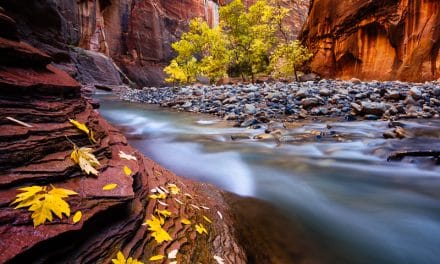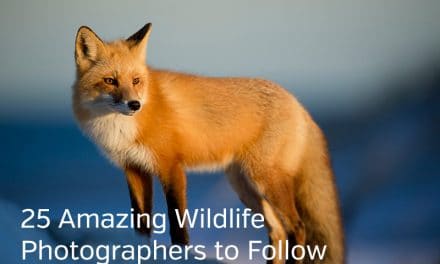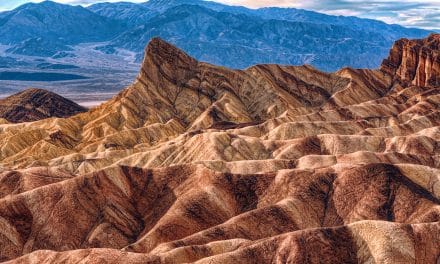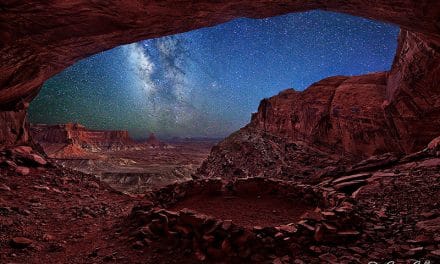![Collared Aracari [Pteroglossus torquatus]; Santa Fe, Panama](https://llandscapes-10674.kxcdn.com/wp-content/uploads/2018/03/aracari.jpg)
Collared Aracari [Pteroglossus torquatus]; Santa Fe, Panama
Walking along this trail one thing becomes clear, we’ve been away from the tropics for way too long. Heliconias, red and yellow glow in a sea of green. Sweat runs in rivulets down my face, heat and humidity, the necessary ingredients for this untamed mass of life, hard to handle after years spent in Colorado. Howler Monkeys roar and howl from mid‑level in the trees overhead, a misty rain drifts through the canopy, makes my shirt even wetter but doesn’t cool. Surrounded by an almost unbelievable diversity of life, plant, animal and insect make a dreamscape for a photographer.
After a 10 year absence from the new world tropics we decided on a trip to Panama to renew a love affair that started in Costa Rica (that affair ended up as a book on the common plants of CR) in the early ’90s and to see if living here full‑time was possible; but also to be surrounded by the incredible medley of life, the colors, the sounds, the smells that mark the neotropics as a place of extraordinary biodiversity. This account is a blend of 2 trips, one in 2014 and the last in 2017. Both trips were during the rainy season (green season) which is not constant or even consistent. Some days have no rain at all and generally mornings are clear with the breath of the rain forest, like a gossamer film, sliding through and over the jungle. Occasionally it will rain all day. All bets were off in 2017 when a tropical storm churned up the Caribbean coast of western Panama up to Nicaragua causing massive downpours, described as “biblical” by some. Those rains developed on the Pacific side of these countries, rains that seemed they couldn’t come down harder, then did and at that point increased yet again. Rivers churned brown with mud, tree trunks sluiced toward the ocean.
![Rufous Motmot [Baryphthengus martii]; Soberania National Park, Panama](https://llandscapes-10674.kxcdn.com/wp-content/uploads/2018/03/panama.jpg)
Rufous Motmot [Baryphthengus martii]; Soberania National Park, Panama
After surviving the drive out of Panama City, something you really don’t want to do, surviving is good, the driving is not. A little clarification, first trip we picked up our rental car in downtown and found a traffic system that seemed devoid of rules and was not an experience I would want to have again. Our second trip we stayed in Casco Viejo (Old Town) an area on the edge of Panama City and of picturesque old crumbling buildings, some in various stages of renovation, very old churches, good restaurants and very nice places to stay. The view across the Bay of Panama at night from Casco is not to be missed, find a restaurant with a roof top dining area . A taxi to our car rental on the outskirts of the city solved the insane traffic problem.
![Green Honeycreeper [Chlorophanes spiza] male; Gamboa, Panama](https://llandscapes-10674.kxcdn.com/wp-content/uploads/2018/03/honeycreeper.jpg)
Green Honeycreeper [Chlorophanes spiza] male; Gamboa, Panama
![Mantled Howler Monkey [Allouata palliata] adult browsing canopy; Soberania National Park, Panama](https://llandscapes-10674.kxcdn.com/wp-content/uploads/2018/03/howler-monkey-2.jpg)
Mantled Howler Monkey [Allouata palliata] adult browsing canopy; Soberania National Park, Panama
![White-necked Jacobin [Florisuga mellivora] male; Soberania National Park, Panama](https://llandscapes-10674.kxcdn.com/wp-content/uploads/2018/03/soberana.jpg)
White-necked Jacobin [Florisuga mellivora] male; Soberania National Park, Panama
![Central American Agouti [Dasyprocta punctata] foraging; Gamboa, Panama](https://llandscapes-10674.kxcdn.com/wp-content/uploads/2018/03/agouti.jpg)
Central American Agouti [Dasyprocta punctata] foraging; Gamboa, Panama
Our first trip took us to some of the towns whose elevation promised a little cooler experience. El Valle de Anton, sitting in the crater of an extinct volcano was our first highland stop. It is home of the almost mythical Golden Frog housed now at the Amphibian Conservation Center (the only place you will see them in Panama) along with other critically endangered amphibian species. The hope is with captive breeding programs that these species will eventually be re‑introduced to the wild.
![Panamanian Golden Frog [Atelopus zeteki], critically endangered frog; , reproductive facility; El Valle Amphibian Conservation Center, El Valle, Panama](https://llandscapes-10674.kxcdn.com/wp-content/uploads/2018/03/golden-frog.jpg)
Panamanian Golden Frog [Atelopus zeteki], critically endangered frog; , reproductive facility; El Valle Amphibian Conservation Center, El Valle, Panama
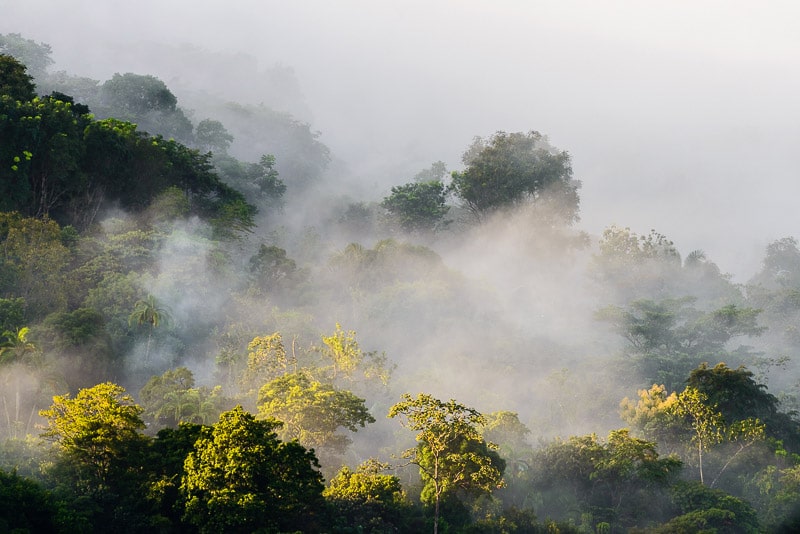
Sunrise over misty mountain rainforests view from Casa Mariposa; Santa Fe, Panama
Sadly this improved road will change the character of the area but will hopefully prompt the government to a better job of protecting the park. The road is now paved (2017) as far as the village of El Guabal. It’s “improved” for some distance north, not a good bet if it has been raining much, a 4 wheel drive will not survive the mud.
![Flag-footed Bug [Anisocelis flavolineata] on Passionfruit vine; Casa Mariposa, Santa Fe, Panama](https://llandscapes-10674.kxcdn.com/wp-content/uploads/2018/03/flag-footed.jpg)
Flag-footed Bug [Anisocelis flavolineata] on Passionfruit vine; Casa Mariposa, Santa Fe, Panama
![Green Violet-ear Hummingbird [Colibri thalassinus] nectaring; Bajo Grande, Cerro Punta, Panama](https://llandscapes-10674.kxcdn.com/wp-content/uploads/2018/03/hummingbird-2.jpg)
Green Violet-ear Hummingbird [Colibri thalassinus] nectaring; Bajo Grande, Cerro Punta, Panama
![Rufous-tailed Hummingbird [Amazillia tzacatl]; Nueva Suiza, Panama](https://llandscapes-10674.kxcdn.com/wp-content/uploads/2018/03/hummingbird.jpg)
Rufous-tailed Hummingbird [Amazillia tzacatl]; Nueva Suiza, Panama
We spent a few evenings after dark chasing frog calls, always hopeful of seeing the singer and getting a photo (finding an ID comes later) while being distracted by constellations of stars in the trees and across the grass, watching a firefly flash from one perch to another releasing its cold fire into the warm night.
No sleeping in with parrots flying in pairs from roost to feeding areas, calling constantly, Orange‑chinned Parakeets chatter and screech back and forth from a Cecropia tree full of fruit. Howlers start up fairly early, prompting you out to see what wonders wait, always something new and intriguing.
Deforested, with the only desert (man-made) in Panama, the Azuero Peninsula doesn’t seem like a photographers destination but there is more here than might be apparent by that description. The Azuero is the traditional heart of Panama with a festival somewhere almost every day of the year. While it is true that most of the area is farm or grazing land there are more wooded areas than “deforested” would indicate. We stayed near Playa Venao, south of the colorful town of Pedasi on a ranch that has been reforesting with native trees (over 30,000 in 10 years) at an astonishing rate. Proof that cattle can be raised and still have forest with plentiful birdlife and other critters. Many of the native species have been returning.

Sunset on Pacific coast from Playa Venao, Panama
Surfers have been visiting the coast of the Azuero for years and there was little tourist infrastructure but that is changing. It is still a fairly quiet region with small fishing villages along the sublime coast. Howlers in the trees, Macaws cruising the coast between roost and feeding areas, Yellow‑headed Carcaras on roadside fence posts, sunset over the wave pummeled shore, not a bad place to visit.
If you’d like to learn more about Larry and Barbara, or view more of their photos, please visit www.pronghornwildlifephotography.com.
All photos in this post are © Larry Kimball & Barbara Magnuson, used with permission.


